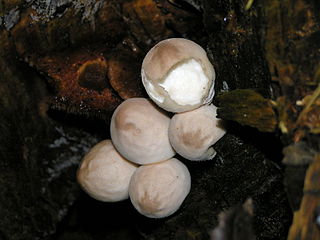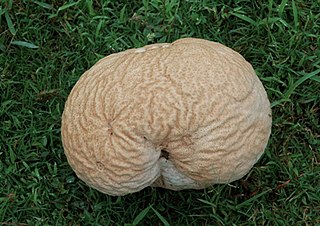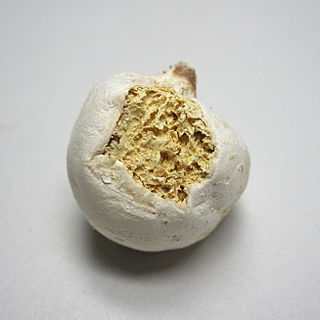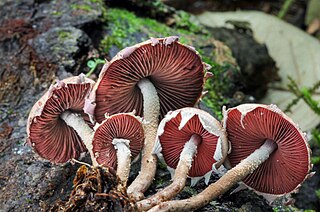Related Research Articles

Lycoperdon is a genus of puffball mushrooms. The genus has a widespread distribution and contains about 50 species. In general, it contains the smaller species such as the pear-shaped puffball and the gem-studded puffball. It was formerly classified within the now-obsolete order Lycoperdales, as the type genus which, following a restructuring of fungal taxonomy brought about by molecular phylogeny, has been split. Lycoperdon is now placed in the family Agaricaceae of the order Agaricales.

Lepiota is a genus of gilled mushrooms in the family Agaricaceae. All Lepiota species are ground-dwelling saprotrophs with a preference for rich, calcareous soils. Basidiocarps are agaricoid with whitish spores, typically with scaly caps and a ring on the stipe. Around 400 species of Lepiota are currently recognized worldwide. Many species are poisonous, some lethally so.

The Agaricaceae are a family of basidiomycete fungi and include the genus Agaricus, as well as basidiomycetes previously classified in the families Tulostomataceae, Lepiotaceae, and Lycoperdaceae.

Coprinus is a small genus of mushroom-forming fungi consisting of Coprinus comatus - the shaggy ink cap (British) or shaggy mane (American) - and several of its close relatives. Until 2001, Coprinus was a large genus consisting of all agaric species in which the lamellae autodigested to release their spores. The black ink-like liquid this creates gave these species their common name "ink cap" (British) or "inky cap" (American).

Calvatia is a genus of puffball mushrooms that includes the spectacular giant puffball C. gigantea. It was formerly classified within the now-obsolete order Lycoperdales, which, following a restructuring of fungal taxonomy brought about by molecular phylogeny, has been split; the puffballs, Calvatia spp. are now placed in the family Agaricaceae of the order Agaricales.

The Psathyrellaceae are a family of dark-spored agarics that generally have rather soft, fragile fruiting bodies, and are characterized by black, dark brown, rarely reddish, or even pastel-colored spore prints. About 50% of species produce fruiting bodies that dissolve into ink-like ooze when the spores are mature via autodigestion. Prior to phylogenetic research based upon DNA comparisons, most of the species that autodigested were classified as Coprinaceae, which contained all of the inky-cap mushrooms. However, the type species of Coprinus, Coprinus comatus, and a few other species, were found to be more closely related to Agaricaceae. The former genus Coprinus was split between two families, and the name "Coprinaceae" became a synonym of Agaricaceae in its 21st-century phylogenetic redefinition. Note that in the 19th and early 20th centuries the family name Agaricaceae had far broader application, while in the late 20th century it had a narrower application. The family name Psathyrellaceae is based on the former Coprinaceae subfamily name Psathyrelloideae. The type genus Psathyrella consists of species that produce fruiting bodies which do not liquify via autodigestion. Psathyrella remained a polyphyletic genus until it was split into several genera including 3 new ones in 2015. Lacrymaria is another genus that does not autodigest its fruiting bodies. It is characterized by rough basidiospores and lamellar edges that exude beads of clear liquid when in prime condition, hence the Latin reference, lacryma (tears).

Leucocoprinus is a genus of fungi in the family Agaricaceae. Its best-known member is the yellow pot-plant mushroom, found worldwide. The type species is Leucocoprinus cepistipes. The genus has a widespread distribution and contains about 40 species. It includes some highly derived cultivars grown by the Acromyrmex and Atta leaf-cutting ants in an evolved ant–fungus mutualism.
Attamyces is a fungal genus in the family Agaricaceae. This is a monotypic genus, containing the single species Attamyces bromatificus. The fungus was found fruiting on the nest of the fungus-growing ants Atta insularis in Cuba. Both the species and genus were described by German mycologist Hanns Kreisel in 1972. The specific epithet bromatificus refers to bromatia, which are swollen tips on the hyphae that the ants use as food.
Endolepiotula is a fungal genus in the family Agaricaceae. This is a monotypic genus, containing the single secotioid species Endolepiotula ruizlealii. This fungus was found in Mendoza Province, Argentina, growing in sandy soil in somewhat dry environment after rainfall.

Disciseda is a genus of gasteroid fungi in the family Agaricaceae. It is a widely distributed genus that is prevalent in arid zones. Disciseda was circumscribed by mycologist Vassiliĭ Matveievitch Czernajew in 1845.
Glyptoderma is a fungal genus in the family Agaricaceae. It is a monotypic genus, containing the single species Glyptoderma coelatum.

Holocotylon is a genus of fungi in the family Agaricaceae. It was circumscribed by American mycologist Curtis Gates Lloyd in 1906 with H. brandegeeanum as the type species.

Melanophyllum is a genus of fungi in the family Agaricaceae. The widespread genus contains four species.
Singerina is a fungal genus in the family Agaricaceae. It is a monotypic genus, containing the single species Singerina indica, found in Maharashtra, southwest India.
Smithiogaster is a fungal genus in the family Agaricaceae. It is a monotypic genus, containing the single gasteroid species Smithiogaster volvoagaricus. Smithiogaster was circumscribed by J.E.Wright in 1975.

Tulostoma is a genus of fungi in the family Agaricaceae. Species in the genus are commonly known as stalkballs, or stalked puffballs.
Smithiomyces is a genus of fungi in the family Agaricaceae. It was circumscribed by Rolf Singer in 1944. The type species, S. mexicanus, was formerly placed in Amanita, as well as the now obsolete Leucomyces and Venenarius. The genus was named to honor American mycologist Alexander H. Smith. S. dominicanus was described from the Dominican Republic in 2015.

Coniolepiota is a fungal genus in the family Agaricaceae. The genus is monotypic, containing only a single species, Coniolepiota spongodes. It was first described from Thailand, and later also reported from Bangladesh and China.
Morganella is a genus of puffball fungi in the family Agaricaceae. The genus name honors American botanist Andrew Price Morgan (1836–1907). The widely distributed genus is prevalent in tropical areas. A 2008 estimate placed nine species in Morganella, but several new species have since been described.
Eriocybe is a fungal genus in the family Agaricaceae. Circumscribed by mycologist Else Vellinga in 2011, it is a monotypic genus, containing the single species Eriocybe chionea, found in northern Thailand. The genus name is derived from the Ancient Greek words ἔριον, meaning "wool" and κύβη, "head". The specific epithet comes from the Latin translation of the Greek χιόνεος, meaning "snow white".
References
- ↑ "Synonymy: Metraria (Cooke) Cooke & Massee". Species Fungorum. CAB International. Retrieved 2016-01-09.